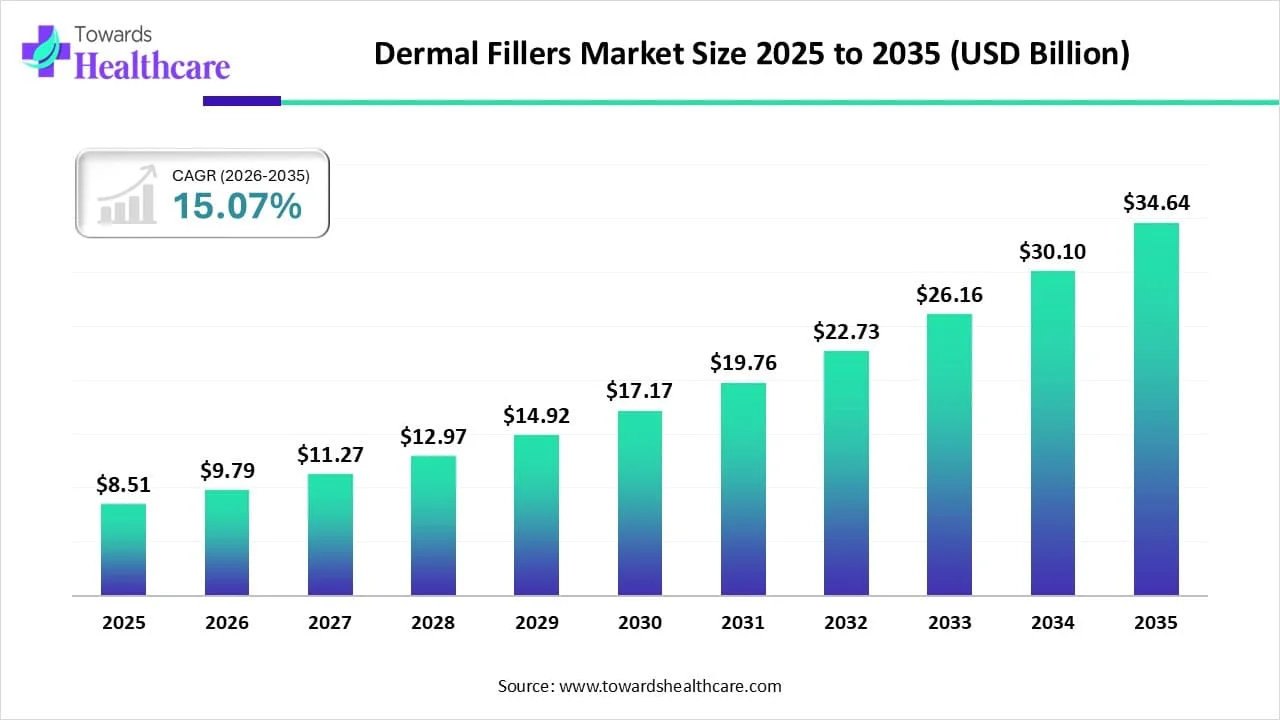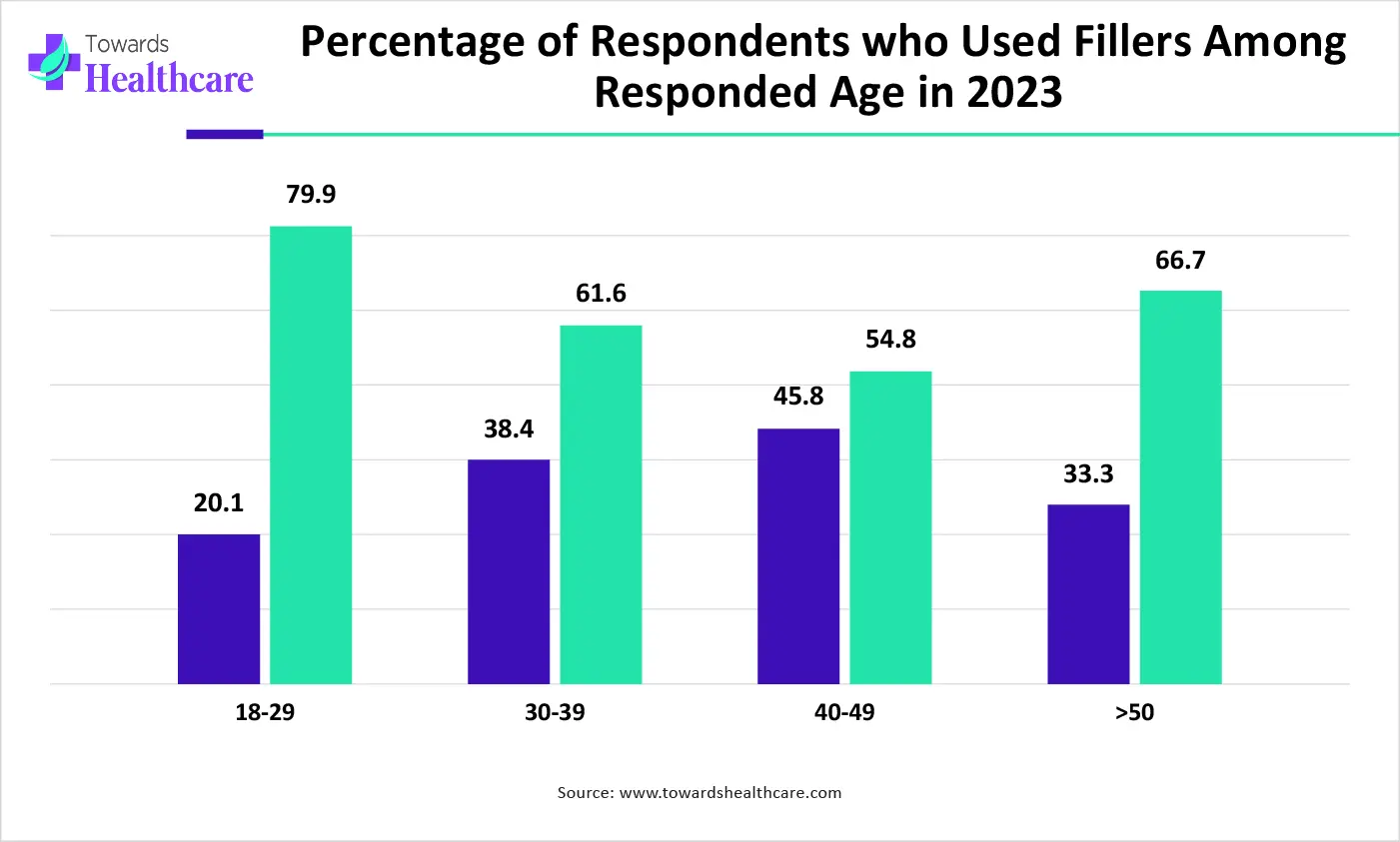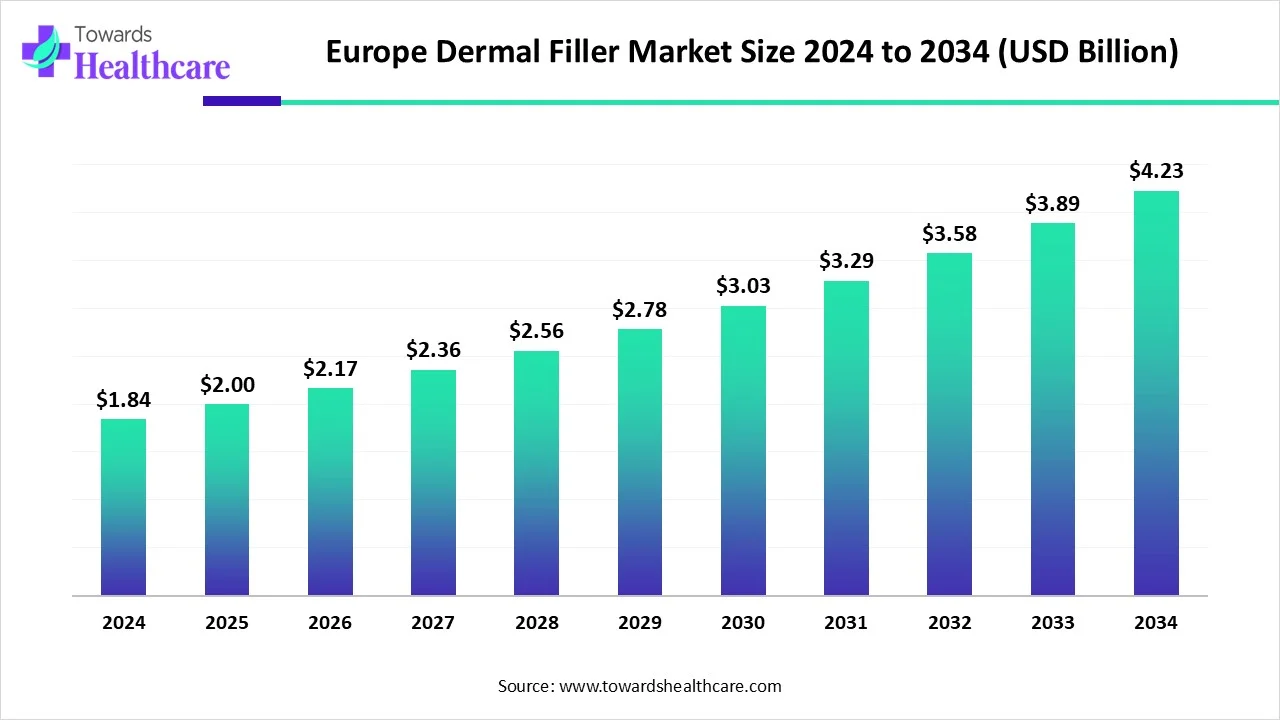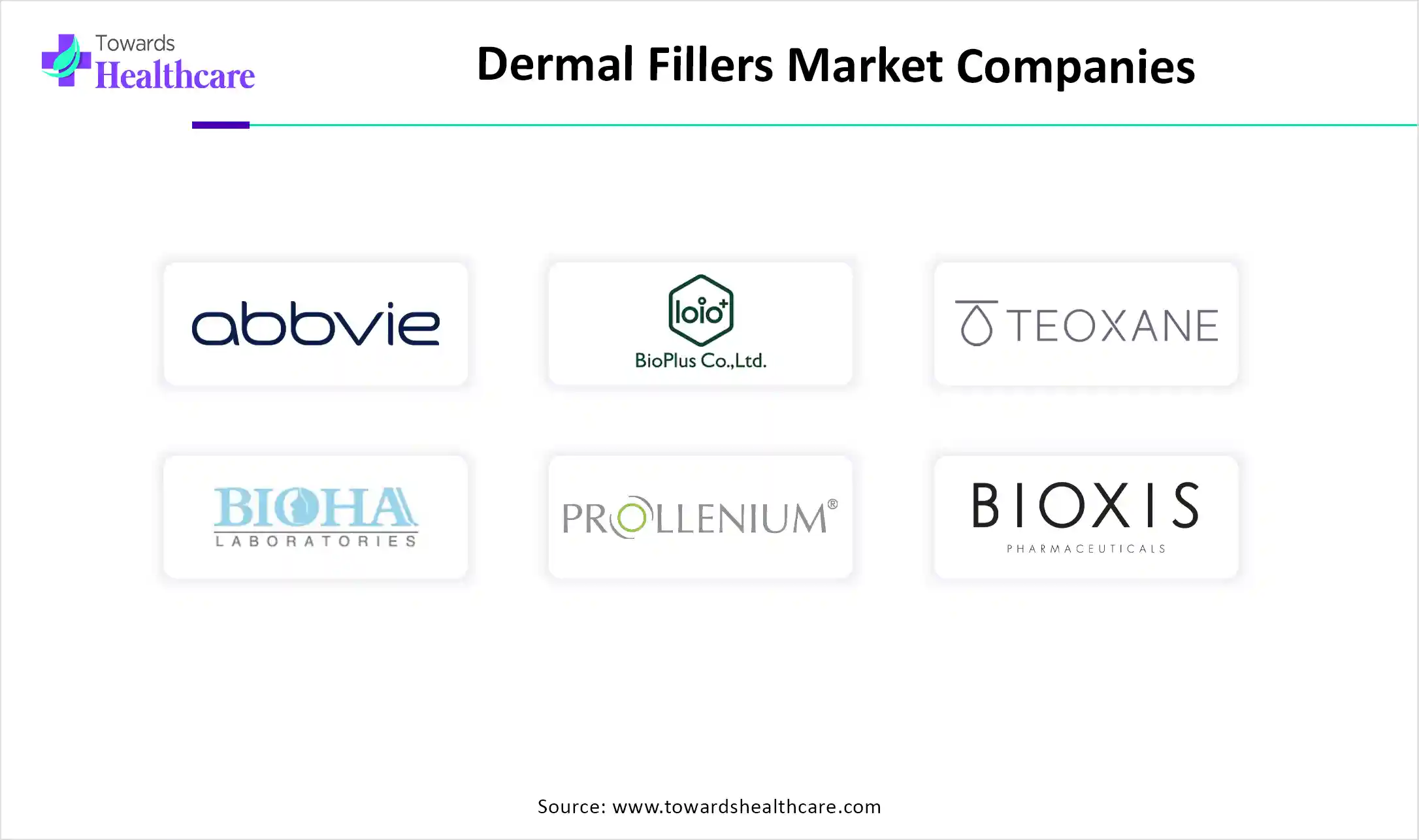December 2025

The global dermal fillers market size is calculated at USD 8.51 billion in 2025, grow to USD 9.79 billion in 2026, and is projected to reach around USD 34.64 billion by 2035. The market is expanding at a CAGR of 15.07% between 2026 and 2035.

| Metric | Details |
| Market Size in 2025 | USD 8.51 Billion |
| Projected Market Size in 2035 | USD 34.64 Billion |
| CAGR (2026 - 2035) | 15.07% |
| Leading Region | North America |
| Market Segmentation | By Type, By Application, By End User, By Region |
| Top Key Players | AbbVie, Inc., HUADONG MEDICINE CO., LTD, BIOPLUS CO., LTD., TEOXANE LABORATORIES, BIOHA LABORATORIES, Prollenium Medical Technologies, Galderma, Merz Pharma, Suneva Medical, BIOXIS pharmaceuticals, Anika Therapeutics, Inc |
Dermal fillers are medical-grade injectable substances designed to add volume, smooth fine lines and wrinkles, and enhance facial features by being placed beneath the skin. They are commonly composed of material like hyaluronic acid, calcium hydroxylapatite, or poly-L-lactic acid, and are used in aesthetic medicine for non-surgical facial rejuvenation. The market is experiencing growth due to rising demand for non-invasive cosmetics procedure that provides quick, natural-looking results with minimal recovery time. Increased awareness of aesthetic treatment, heavily influenced by social media trends and celebrity culture, is driving interest among a broader demographic, including younger individuals and men. Technological advancements have improved the safety and longevity of fillers, making them more appealing. Additionally, the global aging population is seeking effective anti-aging solutions, further fueling market expansion across both developed and emerging economies.

AI can significantly impact the market by enhancing personalized treatment planning and improving outcomes. AI-powered tools can analyze facial structures and skin conditions to recommend the most suitable filler types and injection techniques for individual patients, leading to more precise and effective results. Additionally, AI can optimize product development by analyzing consumer trends and feedback, aiding in the creation of advanced fillers. Furthermore, AI can help streamline the patient consultation process through virtual assessments and provide real-time monitoring during procedures, enhancing both safety and patient satisfaction.
In February 2025, according to the DR. Sales Direct article, AI-driven imaging systems utilize advanced 3D scanning technology to create detailed facial maps, identifying areas suitable for filler application. These systems predict how fillers will interact with different skin types and facial structures, allowing practitioners to simulate potential outcomes before treatment. This predictive capability helps manage patient expectations and reduces the risk of overcorrection.
Minimally Invasive Cosmetic Procedures
Minimally invasive cosmetic procedures, like dermal fillers, are fueling market growth due to their numerous advantages over traditional surgeries. These treatments offer quicker recovery times, minimal discomfort, and fewer risks, making them attractive to individuals seeking facial rejuvenation without the long downtime associated with surgery. They are also affordable, making aesthetic procedures accessible to a larger audience. Additionally, these treatments require no general anesthesia, further enhancing their appeal. As society becomes more accepting of non-surgical enhancement and awareness of these options rises, the demand for dermal fillers continues to grow across diverse dermal fillers markets.
The American Society of Plastic Surgeons' 2023 report reveals that around 23.7 million minimally invasive cosmetic procedures were performed in 2023. These impressive numbers highlight the growing trend and increasing popularity of non-surgical aesthetic treatments, showcasing a significant rise in consumer demand for such procedures.
High Cost and Potential Side Effects
The expense of dermal filler treatments, including consultations, the procedure itself, and follow-up care, can make them inaccessible to a large portion of consumers. Additionally, while generally safe, dermal fillers can sometimes cause side effects such as bruising, swelling, or more serious complications, which can deter potential patients. Concerns over safety and the financial investment required can limit the wider adoption of these treatments, especially in emerging markets or among budget-conscious individuals.
Aesthetic Trends for Facial Rejuvenation
As people increasingly prefer non-invasive treatments over surgery, dermal fillers offer effective solutions for reducing wrinkles, restoring volume, and enhancing facial features with minimal downtime. The aging population, heightened beauty standards influenced by social media, and advancements in filler technology contribute to rising demand. Additionally, dermal fillers' ability to provide personalized, natural-looking results and increasing acceptance in society have boosted their popularity. The expansion of aesthetic clinics has made these treatments more accessible, further fueling the dermal fillers market growth.
In November 2023, CollPlant Biotechnologies revealed that the U.S. Patent and Trademark Office had granted a patent for its photocurable dermal filler. This innovative product is designed to promote skin lifting and aid in tissue regeneration.
By type, the hyaluronic acid segment held a dominant presence in the market in 2024. Hyaluronic acid (HA) is a naturally occurring substance in the body, making it a safer and more biocompatible option for facial rejuvenation. It effectively restores volume, smooths wrinkles, and enhances facial contours with minimal risk of adverse reactions. HA-based fillers offer immediate, noticeable results with relatively low downtime, making them highly appealing to consumers. Additionally, the ease of injection and the temporary nature of the results allow for flexibility in treatment, further driving their popularity in the dermal fillers market.
In August 2023, Maypharm launched SEDY FILL, a hyaluronic acid-based dermal filler specifically developed for non-surgical body shape correction. This product is made with the help of cross-linked hyaluronic acid, which is produced by innovative HENM technology.
By type, the calcium hydroxylapatite segment is anticipated to grow at the fastest rate in the market during the studied years. The calcium hydroxylapatite fillers, known for their ability to provide long-lasting results, are increasingly sought after for facial volumization, wrinkles reduction, and facial contouring. They are also praised for their natural, biocompatible properties, as calcium hydroxylapatite substances are naturally found in bones, making them well-tolerated by the body. Additionally, calcium hydroxylapatite fillers stimulate collagen production. Leading to more youthful, rejuvenated skin over time. These benefits, combined with growing consumer preference for durable and natural-looking results, are driving the rapid growth of the dermal fillers market.
In April 2023, Allergan Aesthetics introduced HArmonyCa, an injectable dermal filler containing Lidocaine. This product combines calcium hydroxylapatite (CaHA) for long-lasting collagen stimulation and hyaluronic acid for an immediate lifting effect.
By application, the facial line correction segment held the largest share of the market in 2024 and is estimated to be the fastest growing during the forecast period, due to the increasing demand for non-invasive treatments to reduce wrinkles and fine lines. As people age, the appearance of facial lines becomes a primary concern, leading many individuals to seek quick and effective solutions. Dermal fillers, particularly those targeting facial lines, offer immediate and noticeable results with minimal downtime, making them highly popular. Additionally, advancements in filler formulations that provide natural-looking outcomes and longer-lasting effects contribute to market growth.
By end-user, the specialty & dermatology clinics segment was dominant in the dermal fillers market in 2024 and is expected to grow at the fastest rate in the coming years. These clinics are often equipped with experienced professionals who can perform dermal filler procedures with precision, ensuring better outcomes and minimizing risks. Patients seeking aesthetic treatments prefer these specialized settings for their expertise, advanced equipment, and personalized care. Additionally, as the demand for cosmetic treatments rises, more people are turning to dermatology clinics for professional services, contributing to the segment's rapid growth. The availability of tailored treatments and a trusted environment further drives the dominance in the dermal fillers market.
In June 2023, CAVENDISH CLINIC teamed up with John Lewis Plc to offer aesthetic and beauty treatments, including dermal fillers, at select stores throughout the U.K. Moreover, procedures like wrinkle correction, which do not require hospitalization, have helped drive the growth of the dermal filler market.
North America dominated the global dermal fillers market in 2024. The region has a high demand for aesthetic treatments, driven by a strong cultural focus on appearance and personal grooming. Additionally, the presence of advanced healthcare infrastructure, highly trained professionals, and a large number of aesthetic clinics makes North America a leader in dermal filler procedures. The increasing popularity of non-invasive treatment, including wrinkle reduction and facial contouring, awareness, and acceptance of cosmetic procedures among consumers in the U.S. and Canada contribute to the region’s dominance.
The U.S. market is expanding rapidly due to several influential factors. There is a rising preference for non-surgical cosmetic procedures, such as wrinkle reduction and volume restoration, as they offer quicker recovery times and fewer risks compared to invasive surgeries. Technological advancements in filler formulation and injection techniques have improved safety, effectiveness, and longevity, increasing consumer confidence. Additionally, the market is benefiting from a broader demographic, including more male patients seeking aesthetic treatment. States like California, New York, and Florida, known for their strong beauty and wellness culture and high disposable incomes, are also driving the market growth.
The expansion is largely driven by an aging population seeking non-invasive treatment to combat signs of aging, such as wrinkles and volume loss. Technological advancements, including the introduction of innovative products like Galderma’s Restylane Eyelight, have improved the safety and effectiveness of fillers, attracting a broader customer base. Additionally, cultural shifts, including growing interest in aesthetics and the influence of social media, have made cosmetic enhancements more mainstream and widely accepted across Canada.
The Europe dermal fillers market is valued at USD 1.84 billion in 2024, expected to reach USD 2 billion in 2025, and projected to grow to about USD 4.23 billion by 2034, with a CAGR of 8.84% from 2025 to 2034.

Europe held the second-largest share of the dermal fillers market in 2024. The region has a well-established healthcare infrastructure and an increasing adoption of advanced cosmetic procedures among younger age groups. The rapid expansion of medical tourism, especially in countries like Turkey, Poland, and Hungary, where high-quality aesthetic treatments are offered at competitive prices. Moreover, rising awareness campaigns, frequent product launches by leading companies, and collaborations with aesthetic clinics are encouraging wider usage. The growing influence of fashion and beauty trends across Europe further drives demand for facial enhancement and rejuvenation procedures.
The UK market is growing steadily, driven by the rising popularity of non-surgical cosmetic treatments. Consumers are increasingly opting for procedures like facial line correction, lip enhancement, and volume restoration due to their minimal downtime and lower risk compared to traditional surgeries. Technological advancements in filler formulations and injection techniques have made these treatments safe, longer-lasting, and more effective, boosting their appeal. Additionally, a more diverse group of consumers, including younger individuals and men, is now engaging in aesthetic procedures. Major urban centers like London and Manchester are leading the trend, supported by high disposable incomes and a strong beauty culture.
The country’s aging population is increasingly opting for non-invasive aesthetic procedures to address signs of aging, such as wrinkles and volume loss. There is also a growing acceptance of cosmetic enhancements. Additionally, the popularity of minimally invasive treatments, which offer quicker recovery times and fewer risks compared to traditional surgeries, is contributing to market growth. Germany’s well-established healthcare infrastructure and the safe and effective use of dermal fillers. Furthermore, the introduction of advanced products, particularly hyaluronic acid-based fillers, is enhancing patient satisfaction and filling demand.
Asia-Pacific is expected to see significant growth in the dermal fillers market during the forecast period, as a rise in the aging population, particularly in countries like Japan, China, and South Korea, is driving demand for non-invasive treatments. Increased beauty consciousness among young and middle-aged consumers further contributes to market growth. Technological advancements in filler formulations and injection techniques have enhanced treatment safety and effectiveness. Additionally, medical tourism in countries like South Korea and Thailand is boosting demand, positioning the region as a leader in aesthetic enhancement.
China’s market is growing due to rising disposable incomes, which have made aesthetic treatments more accessible to a larger population. The aging population is also driving demand for non-invasive solutions to address signs of aging. Technological advancements in filler formulation and injection techniques have enhanced safety and effectiveness, attracting more consumers. Additionally, the influence of social media platforms like WeChat and Weibo, along with celebrity endorsement, has increased the awareness and popularity of dermal fillers, further expanding market growth.
In June 2023, Croma-Pharma announced the start of a clinical trial for its hyaluronic acid dermal filler, Princess® Volume Plus Lidocaine, in China. The Phase 3 trial, led by Lanzhou Biotechnique Development, aims to evaluate the filler’s safety and effectiveness for mid-facial volume loss. The study will involve 600 patients across 15 centers, focusing on mid-facial augmentation.
India’s market is expanding due to shifting attitudes towards aesthetics, especially among the younger population. As beauty and self-care become more mainstream, there is a growing demand for procedures like wrinkle reduction and lip enhancement. Furthermore, the increasing availability of dermal filler products and the rise of social media trends have made these treatments more desirable and accessible. India is also witnessing a surge in medical professionals offering advanced training in dermal filler administration, boosting consumers' confidence. As awareness grows, dermal fillers are becoming a common choice for those seeking youthful, refreshed appearances.

In February 2025, Evolus, Inc. announced that the U.S. Food and Drug Administration (FDA) had approved its injectable hyaluronic acid (HA) gels, Evolyss Form and Evolysse Smooth, marking the company's entry into the U.S. HA dermal filler market. This approval expands Evolus' portfolio and increases its addressable market by 78%, reaching approximately $6 billion. David Moatazedi, President and CEO of Evolus, expressed that this milestone is a significant step in the company's strategy to evolve from a single-product company to a multi-product innovator, reinforcing its leadership in performance beauty.
By Type
By Application
By End User
By Region
December 2025
December 2025
December 2025
December 2025